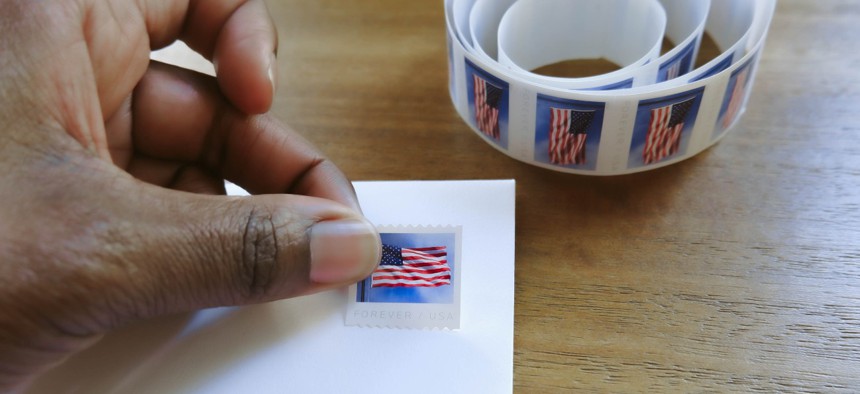
The price of a stamp will increase to $0.63 next year. Grace Cary / Getty Images
The U.S. Postal Service Is Set to Raise Prices, Again
The Postal Services cites inflation for the change, though the increases were long anticipated.
The U.S. Postal Service plans to increase the price of a stamp to $0.63 next year, part of a 4.2% overall increase from current First-Class mail rates.
The hike is the full amount authorized under the mailing agency’s rate-setting authority and would mark the latest of several significant increases under Postmaster General Louis DeJoy. USPS said the change was necessary to keep pace with inflation, though DeJoy has previously suggested the increases would continue to allow the Postal Service to reach a financial break-even point.
The USPS board of governors has signed off on the price spike, but it must still receive final approval from the Postal Regulatory Commission. The commission allowed for the higher increases in 2020 and DeJoy has tapped into the authority on multiple occasions, calling them a key part of his plan to allow USPS to find firmer financial footing. Approval of the increases will amount to a simple checking of the math to ensure postal management stayed within its allowable formula.
In July, USPS raised its overall prices for regular, First-Class mail by 6.5% and increased them by 8.5% for package services. Since 2019, the cost of a stamp has jumped by 26%.
The Postal Service plans—set to take effect Jan. 22, 2023—to increase the cost of a postcard by 9% to $0.48. The cost of sending a letter internationally is set to jump from $1.40 to $1.45.
“As operating expenses continue to rise, these price adjustments provide the Postal Service with much needed revenue to achieve the financial stability sought by its Delivering for America 10-year plan,” the Postal Service said. “The prices of the U.S. Postal Service remain among the most affordable in the world.”
Earlier this year, DeJoy told the mailing industry to be prepared for ongoing, “uncomfortable” rate hikes. The expected $107 billion in financial relief from the Postal Service Reform Act that President Biden signed into law in April would not be enough to make USPS solvent, DeJoy said, as it still anticipates between $60 billion and $70 billion in long-term losses. The Postal Service experienced a net profit of $59.7 billion in the third quarter of fiscal 2022, which ended June 30. Nearly all of that came from the reform bill’s lifting of the Postal Service’s obligation to pre-fund health benefits for retirees, though USPS is still sitting on more than $22 billion in cash on hand.
The new rate system the Postal Regulatory Commission established in 2020 created a complicated formula for setting prices derived from factors including inflation, declining mail and retiree costs. The Postal Service historically only raised its rates in line with inflation, but since 2021 Postmaster General Louis DeJoy has repeatedly used the new authority to increase prices at a far faster clip.
DeJoy promised as part of his 10-year business plan to use his authority to raise rates above inflation "judiciously," but predicted USPS would generate between $35 billion and $52 billion by 2031 by raising prices. Some lawmakers and stakeholders have criticized DeJoy’s dual approach of raising rates while slowing down delivery for some mail, arguing it will accelerate losses to mail volume. DeJoy has defended his strategy as necessary to set realistic goals and put the agency on firmer long-term financial footing.
Several industry groups have asked the postal regulator to revoke the new rate-setting authority, noting the Postal Service’s financial outlook has changed dramatically since President Biden signed a reform measure into law. That petition is currently pending before the commission. The groups previously sought to block the new authority from taking effect, but they lost the case in federal court. Rep. Gerry Connolly, D-Va., has introduced legislation to revoke the new authority and task PRC with developing a replacement one.
As USPS awaits a decision from PRC on its new prices, it is in the midst of preparing for the election season. A federal judge in Washington, D.C., issued a final ruling last week that faulted policies implemented by Louis DeJoy in 2020 for mail slowdowns ahead of the election that year and put restrictions on USPS from taking similar steps in the future. DeJoy has conceded his move to limit late and extra mail transportation trips caused mail delays to spike and has walked back the change. Going forward, USPS will not be able to alter the policy if mail is delivered 10% more slowly over a two-week period without first receiving a PRC sign off. The same court issued a preliminary injunction on DeJoy’s policies in September 2020.
The Postal Service, ultimately, was overwhelmingly successful in delivering election mail on time in 2020. So far in 2022, it is delivering ballots more quickly than it did two years ago. As part of a settlement agreement, USPS has also pledged to implement “extraordinary measures” in the run up to the election similar to those in place in 2020.
Clarification: This story has been updated to note the rate of price change reflects the overall costs for First-Class mail.







